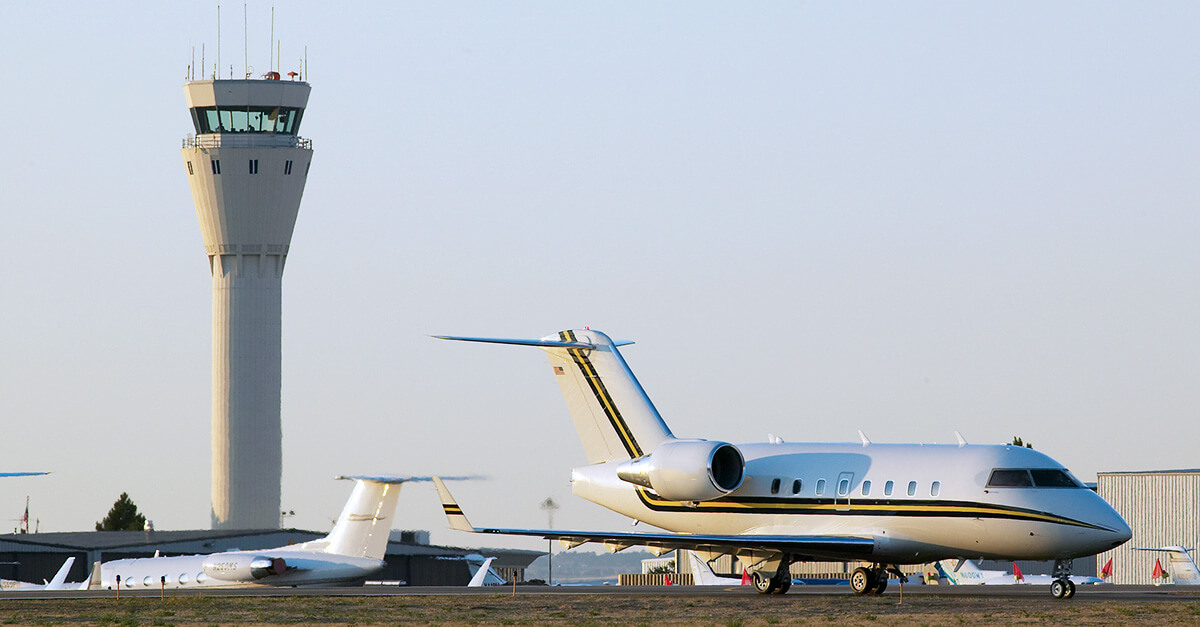

March 4, 2019
As commercial traffic continues growing, business aircraft operators are looking to retain their share of shrinking airport capacity worldwide.
Until the beginning of this year, Singapore’s Seletar Airport was “one of the more business aviation-friendly airports in the Asia-Pacific region,” according to Sarah Kalmeta, a member of the board of governors of the Asia Business Aviation Association (AsBAA). The adjacent Seletar Aerospace Park features more than 30 aerospace companies, such as Bombardier, Execujet and Pratt & Whitney. A new business aviation center has a separate drop-off area with dedicated check-in.
But effective Jan. 1, 2019, in response to noise complaints from local residents, the Civil Aviation Authority of Singapore imposed a night curfew from 10 p.m. to 7 a.m. local time. In addition, some commercial turboprop operations are moving to Seletar from Singapore’s other major airport, Changi, further limiting movements for business aircraft operators that use Seletar.
Worldwide, 204 airports are now designated as Level 3 slot-coordinated facilities, meaning they are effectively at full capacity for runway and park-ing availability. That’s a 27-percent jump from 160 just six years before, according to the International Air Transport Association (IATA). And with commercial passenger air traffic expected to double in the next two decades, many of the 100 Level 2 air-ports (congestion during peak hours or peak times of the year) could become Level 3 airports.
More than half of the world’s slot-coordinated airports are in Europe: London Heathrow, Paris de Gaulle, Frankfurt and Amsterdam are prime exam-ples. The Asia-Pacific region has about 20 percent, with 21 in China alone. In the U.S., capacity-con-strained airports include Washington, DC’s Reagan and New York’s JFK and LaGuardia.
BIAS AGAINST BUSINESS AVIATION
“The main issue for business aircraft operators is that airlines get preference, followed by cargo, and there are oftentimes bans on general aviation operations during certain periods of the day,” said Kalmeta.
In the UK, “business and general aviation is being squeezed from runway and parking capacity, along with new night noise restrictions, which continue to allow the scheduled airlines to grow, but clearly fail to see the value that business and general aviation users bring to the UK,” said Terry Yeomans of the International Business Aviation Council. “If allowed to continue at the current rate, we will see an end to 24-hour operations in the immediate London area and job losses, not just at the fixed-based operators, but at the supporting services.”
“GA must have access to the same technology and airport runways and taxiways as commercial aviation,” stated Cynthia C. E. de Oliveira, oper-ation director for Líder Aviação, which has more than 20 bases at the main Brazilian airports. “We believe that general aviation and commercial oper-ations can work together, and that GA must have access to all airports – especially airports where the investment in FBOs is already done. The perfor-mance of GA airplanes, especially the ones used for international missions, gives us the possibility to operate at the same airports as commercial aircraft, not demanding extra time or different measures to use the runways or taxiways.”

HOW TO OBTAIN A SLOT
The challenges of securing landing and takeoff slots vary around the world. In London, “night is the biggest issue,” said Sean Raftery, Universal Aviation’s managing director for the UK and Ireland. Only Luton and Stansted operate 24 hours a day. However, Luton banned night flights, and Stansted only offered 10 ad-hoc night slots. This winter, Luton has had 33 ad-hoc night slots and Stansted 25, but the number varies month to month. Universal Aviation’s European Operations Manager Perry Gaffney added that at Luton, “the bigger issue is parking space.”
In Tokyo, operators have the choice between operating to Narita, which has a night curfew but permits airplanes to park longer, or Haneda, which is 24/7 but limits parking to 4 nights/5 days maximum. In order to obtain slots at either airport, you must also have your parking spot granted.
In Beijing, during certain periods, such as 9 a.m. to 10 p.m. local time, only one GA movement can take place per hour, so you cannot do a “quick turn” and takeoff again within the same hour. Pudong Airport in Shanghai has the same restriction, and there are no slots for GA between 7 a.m. and 9 a.m. local time.
At Buenos Aires, Argentina’s Aeroparque International Airport, there are restrictions for airplanes carrying fewer than 19 passengers, said de Oliveira, “which means that most GA airplanes will not be allowed to operate there, except governmental flights.”
In China, an aircraft with more than 30 seats is considered to be a “non-scheduled commercial charter” for which a permit is extremely difficult to obtain. Kalmeta said, “There is a pronounced misconception of how operations work in China because they are constantly changing. Crews all talk amongst themselves; some make it sound like it’s very simple, while others may have a negative experience. This is where the line starts to get very blurry.”
There are seasonal congestion issues as well. “Geneva in winter especially, with the snowbirds,” noted Gaffney. Nice Côte d’Azur Airport, serving the French Riviera, quickly fills in summer and for the Cannes Film Festival in May.
DELAYS DON’T WORK ANYMORE
In the past, some operators and ground handlers used delay tactics, booking a slot, for example, for 8 a.m. and applying for delays, finally taking off at 11 a.m..
“As airports have become increasingly busy, the authorities have started to watch more closely,” Kalmeta noted. “The delay became one of those industry practices because it constantly worked. Now we’re seeing the regulations being more strictly enforced, which is changing expectations.” In some cases, the handler is scrambling to coordinate, or the flight is not allowed to depart.
“Make sure your vendors have day-to-day experience in this region because of the high amount of regulation,” advised Phil Balmer, director of maintenance at TAG Aviation Asia and vice chair of AsBAA.
Planning as far in advance as feasible is also standard advice. However, Balmer cautions that “some slots are released fairly late.” There can even be several days differ-ence between approvals for private and charter operators.
“You need to be dynamic,” suggested Balmer. “You might not get that slot until just a couple days before your planned operation. That can be difficult for operators to understand because they don’t get the green light until right at the end.”
Even if you have not yet received a confirmed slot, it’s usually best to make all local ground handling and service arrangements.
In Hong Kong, for example, slot applications are only open 14 days prior to the date of operation. At Haneda Airport in Tokyo, Japan, slots are released on a timetable that varies month to month. Slots may not be requested earlier than seven days prior to the estimated time of arrival for Singapore Changi and are valid for +/- 55 minutes. Beijing Capital is +/- 30 minutes, and earlier departures are sometimes not possible, Nice is -5/+10 minutes, while Geneva has zero slot tolerance. If you miss a confirmed slot, some airports may fine the opera-tor or even detain the crew for several hours.
There are bright spots among slot-restricted airports, however. In 2018, AsBAA secured an increase in slots at Hong Kong on a trial basis – to six, instead of the previous four, for the reduced night period program between midnight and 0459 local time. This followed two years of quarterly slot-coordination meetings with civil aviation and airport authorities. AsBAA and the Japanese Business Aviation Association are also working together to address traffic for the 2019 G20, Rugby World Cup, Japanese Imperial Transition and 2020 Olympics.
Most of the time, with proper advance planning and coordination with your flight planning provider and local ground handler, slot requests and revisions can be accommodated, even at night, and even at airports with more rigorous policies. “Work with them,” said Raftery. “You’ll find most issues can be overcome.”
“Be honest and up front with expectations,” added Gaffney. “It’s always backwards and forwards. When you’re offered the nearest slot to the time requested, sometimes the client accepts. Sometimes they say no, keep pushing. Sometimes they’ll go elsewhere.”
ALTERNATIVES TO CONGESTED INTERNATIONAL AIRPORTS
There is often more than one way to fly into popular international destinations. Here are a few recommendations for business aircraft operators:
- At Guarulhos International Airport near São Paulo, Brazil, parking is extremely expensive and ramp area restrictions substantial. Try Campinas or another airport of entry among the many options the country offers, or reposition to Congonhas, 20 minutes from the financial center of São Paulo. Or even fly into Rio de Janiero, a 45-minute flight hop away.
- I n Buenos Aires, Argentina, the alternatives to Aeroparque International are Jorge Newbery, Ezeiza (no slot required) or San Fernando (but with runway restrictions for larger jets).
- When flying to Manilla in the Philippines, consider using Clark International Airport.
- In Malaysia, Subang Airport (Kuala Lumpur’s main airport until 1998) may be preferable to the newer Kuala Lumpur International.
- The best alternative option for Hong Kong is Macau, though
it can run out of parking, so operators may need to consider relocating their aircraft to Southern China or the Philippines. - Instead of Dubai International, consider Al Maktoum, Sharjah or Abu Dhabi.
- In France, when Nice is not nice, a good alternate is Marseille or Genoa, Italy.
- In London, instead of Heathrow or Gatwick, try Luton, Stansted, London City (it has a steep approach and aircraft certification is required), Southend, Farnborough, Biggin Hill, or Northolt, a current RAF base that allows business jet traffic during very limited opening hours (and plans for runway resurfacing in 2019).
- For Saint Petersburg, Russia, especially for the International Economic Forum in June, try Tallinn, Estonia or even Helsinki.
GENEVA: EUROPE’S BUSINESS AVIATION CAPITAL
Each year, Geneva Airport (GVA) in western Switzerland is one of the top three busiest airports for general aviation in Europe, together with Paris’ Le Bourget and Nice Cote D’Azur. But GVA has an outsized impact, with commercial connections to more than half of the EU’s economic centers for a one-day trip. In addition, the airport has hosted the static aircraft display for the European Business Aviation Convention & Exhibition (EBACE) since the event’s inception in 2001.
“Geneva is quite well connected. It’s easy to come here,” said André Schneider, airport CEO since 2016.
As a concession of the Swiss federal state, the airport’s mission is to serve commercial airline passengers and general aviation. In 2006, GVA handled 10 million passengers; in 2017 the number reached 17.3 million. And by 2030, the forecast is for 25 million. Business jet movements last year totaled about 35,000, or 18 percent, of the airport’s overall traffic.
With the steady rise in airline business and no option for a second runway, Schneider acknowledges that “there will be limits in the future. But we haven’t reached that yet. We need to find adaptive ways to deal with the growth.” The current slot system for general aviation also enables some flexibility for con-trollers “to be more tactical during the day.”
Schneider noted that business aviation is “positive for the evolution of the Geneva region,” which is home to numerous United Nations and non-governmental agencies (the World Trade Organization and World Economic Forum), biotech and pharmaceutical companies, and multinational corporations.
As part of its 2030 strategic plan, GVA is building a second terminal, the so-called “East Wing,” to accommodate long-haul international airlines. Schneider said airport management is also considering larger hangars and more capacity for general aviation on the north side of the airport, against the Jura mountains.


 International Business Aviation Council Ltd.
International Business Aviation Council Ltd.